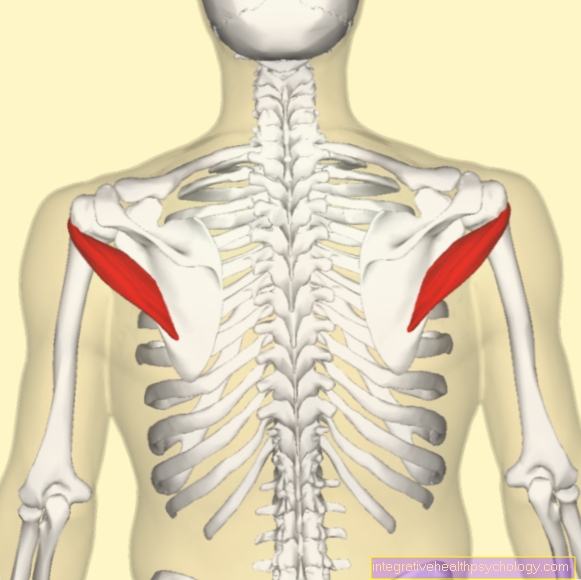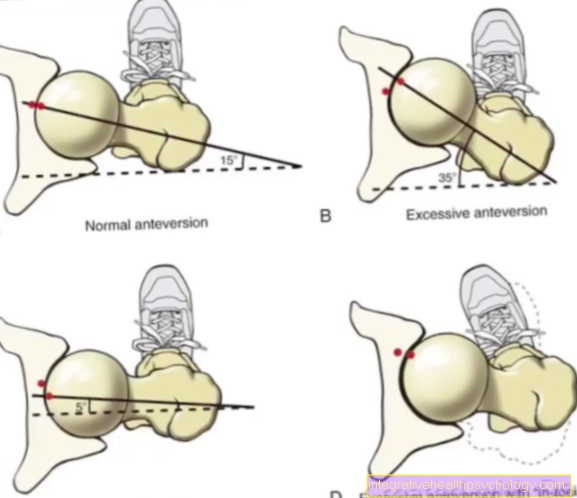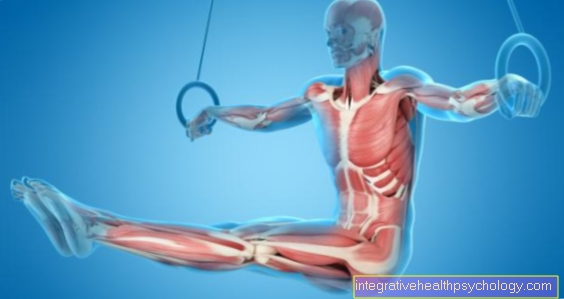Peritoneum
General

The peritoneum (peritoneum, Greek peritonaion = that which is stretched out) serves to seal off the abdominal cavity and the organs in it.
It is divided into a parietal and a visceral sheet according to its structure and covers all the organs of the abdominal cavity below the diaphragm up to the pelvis (the deepest point is the Douglas space). It also produces the peritoneal fluid and is part of the immune system.
Structure of the peritoneum
The total area of the Peritoneum is 1.6 to 2.0 m2 in humans.
There are five on the front wall of the abdominal cavity below the navel Longitudinal foldswhich in surgery as Lead structures be used.
The three central structures come from the Embryonic period and here have the three large vessels for Blood exchange depicted between mother and child.
The structures running laterally contain the Artery and Inferior epigastric veinwhich are used to supply blood to the abdominal wall.
The peritoneum becomes according to its covering structures in a visceral and a parietals Leaf articulated.
- The Peritoneum cavity itself is from parietal sheet of the peritoneum lined.
- The visceral sheet covers liver, spleen, Gallbladder, stomach as well as most of the Thick- and Small intestine.
These organs are also at one Hanging strap, the meso. The sheets of the peritoneum are made by different annoy provided.
The visceral Leaf is mainly made up of the vegetative Nervous system innervated. Parts of the peritoneum via the gallbladder and liver are passed through the Phrenic nerve innervated.
The parietal Leaf becomes sensitive to the Spinal nerves and the Phrenic nerve innervated and is thereby very sensitive to pain.
- The bladder and with the woman
- the uterus,
- Ovaries and
- Fallopian tubes
lie in the so-called Subperitoneal space and invade the parietal sheet of the peritoneum from below. At this point the peritoneum is called the Urogenital peritoneum designated.
function
The peritoneum secreted and absorbed Peritoneal fluid.
This is a clear liquid which is called "lubricant“Serves and the Movability of organs against each other.
This Movability is especially with:
- Stomach filling and the
- digestion, as well as one
- pregnancy necessary.
The amount of liquid is usually no more than 50 ml.
Larger amounts of the Peritoneal fluid are pathological and are considered Ascites designated.
This is a common symptom of
- Liver failure,
- Inflammation or
- Tumor diseases the abdomen or peritoneum.
Too little production of this fluid prevents the organs from moving smoothly against each other and can lead to too Pain or Adhesions of the peritoneum.
A inflammation of the peritoneum (Peritonitis) is a life-threatening complication that occurs after operations or Organ perforation can occur. Furthermore, the peritoneum is used for the airtight Closure the abdominal organs and the Immune defense.
Peritonitis

The Inflammation of the peritoneum, medical Peritonitis called, is an inflammatory process that can arise due to various causes. Depending on the cause, the Peritonitis in a primary as well as a secondary Peritonitis can be classified.
Primary peritonitis makes up only a very small part of the peritonitis that occurs. Inflammation is referred to as such if it occurs without being preceded by disease in other organs in the abdomen.
Basically, any inflammation of the abdominal organs that come into contact with the peritoneum can cause inflammation of the peritoneum. If this is the case, it is called secondary peritonitis. Peritonitis is most commonly associated with a Appendicitis (Appendicitis). Inflammation of other organs can also be accompanied by inflammation of the peritoneum, for example inflammation of the female genital organs. A so-called Diverticulitis is another reason why the peritoneum can become inflamed. In this condition, a part of the large intestine bulges and becomes inflamed, as well as the adjacent peritoneum. If bacteria because of a Intestinal injury get into the abdomen, the peritoneum will almost certainly become inflamed.
The symptoms of peritonitis are differentiated according to disease status. With a locally occurring peritonitis, the general condition of the person concerned is hardly affected. It can also fever occur, but is rarely in the foreground. Of the Tenderness the affected region is a typical symptom of the local peritonitis. A so-called is also typical Defense tension the abdominal muscles, which can be assessed by palpating the abdomen.
However, should a so-called generalized peritonitis are present, the general condition of the person concerned is severely impaired. It shows up Shock symptoms, which with a low blood pressure, rapid pulse rate and high fever goes hand in hand. The abdomen shows a defensive tension and a pronounced sensitivity to pressure when touched.
Acute peritonitis should be diagnosed as quickly as possible by a treating doctor so that specific treatment can be initiated. Therapy for peritonitis is always carried out operational. During the operation, the inflammation should be localized and, if possible, removed, for example by removing an inflamed appendix. Ideally, all bacterial foci that are responsible for inflammation of the peritoneum should also be removed. Usually there is an accompanying therapy, which is mainly the administration of Broad spectrum antibiotics includes, so that a multiplication of the bacteria can be excluded.
Peritoneal dialysis
Carrying out a dialysis becomes necessary when the Kidneys their job of Blood purification can no longer be fair. This is with one Kidney failure the case. Since certain substances occur in the blood that must be removed, otherwise they become toxic to the body, the blood must be artificially purified in these cases.
One method of artificial blood purification is the so-called Peritoneal dialysis Since the peritoneum acts as a kind of membrane that is connected to the blood, certain substances that occur in the blood can be withdrawn and added if necessary. A Dialysis fluid used, with which the peritoneum is washed around a catheter. After a few hours, the substances toxic to the body have accumulated in the liquid and the liquid must be replaced. Since the liquid used also contains sugar (glucose), it draws water from the body, which would normally also be excreted through the kidneys.
The key advantage of the Peritoneal dialysis towards the Hemodialysis is that this too At home can be carried out by the person concerned. In contrast, hemodialysis has to be done in a hospital and also takes several hours.
Peritoneal cancer
Peritoneal cancer, also as Peritoneal carcinosis called, is a malicious Tumor disease, which is usually called Metastases other tumors occurs. In particular, tumors that affect organs that are also located in the abdominal cavity and have reached an advanced stage metastasize particularly frequently into the peritoneum. Depending on the stage of the disease, symptoms may appear that suggest the presence of peritoneal cancer. In addition to non-specific symptoms, such as a poor general condition, Weight loss and Pain Symptoms caused by the growing tumor also appear. Especially Intestinal obstruction and a larger amount Ascites can be triggered by a growing tumor of the peritoneum. The treatment options for diagnosed peritoneal cancer are very limited. A surgical removal the tumor is mostly not possible and the cancer speaks very badly to a conventional one chemotherapy on. There are methods that try to direct chemotherapy directly into the abdomen so that it can work better against cancer. Despite these new surgical procedures, the prognosis for a diagnosed peritoneal cancer can be classified as very poor.
Peritoneum metastases
Tumors, which occur in the peritoneum, arise largely from so-called Primary tumorsthat occur in other, surrounding organs of the abdominal cavity. In particular tumors of the metastasize Intestines, Stomach or for example the Ovaries often in the peritoneum. There is usually a strong dispersion, by which is meant that many Metastases exist, which occur distributed over the peritoneum. Usually these metastases only appear in the Late stage of the underlying primary tumors, which is why the prognosis for healing of the disease is very poor. For some years now, one has been used therapeutically intraoperative chemotherapy which has a greater effect on tumor growth than conventional systemic chemotherapy. The diagnosis of peritoneum metastases turns out to be relatively difficult, since the metastases are very difficult to detect with conventional imaging methods. Most diagnoses are made when the primary tumor is identified or during routine follow-up examinations. Symptoms that affect the general condition and, depending on the size of the metastases, can also cause intestinal problems, can be an indication of the presence of peritoneal metastases.
Summary
The Peritoneum (peritoneum) is an important part of the human abdominal cavity and serves in addition to the
- airtight seal and the
- Movability of the internal organs especially the
- Immune defense and
- Formation of the peritoneal fluid.
Through the sensitive Innervation is that parietal Peritoneum very leaf sensitive to pain and leads to severe pain even with slight irritation.
The inflammation of the peritoneum leads to the clinical picture of the acute absencewhich one as hard as a board designated. The muscular tension of the abdomen, which cannot be influenced, is triggered by the irritation of the peritoneum.
Also the formation of increased Peritoneal fluid is a sign of serious illness and urgently needs a diagnosis.
So the peritoneum serves not only that protection of the organs. His Functionality represents an important diagnostic criterion.




























